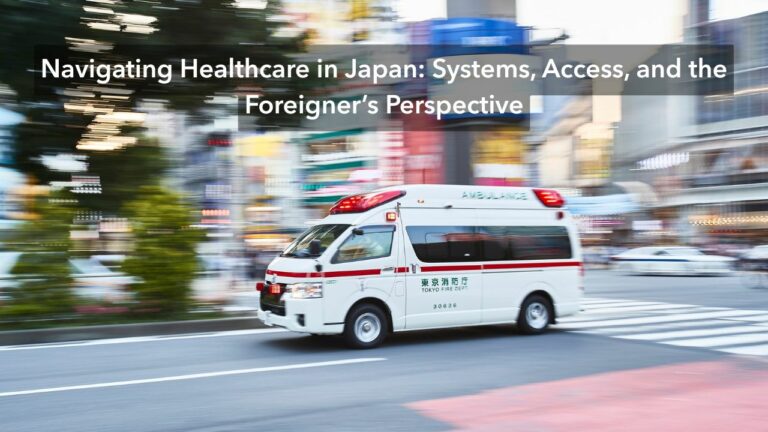Navigating Healthcare in Japan: Systems, Access, and the Foreigner’s Perspective (Revised)
Japan’s healthcare system is often cited as one of the most efficient and accessible in the world, offering a blend of public insurance, regulated costs, and high-quality care. But behind the statistics lies a complex landscape shaped by demographics, geography, cultural expectations, and policy evolution. For foreign residents and travelers alike, understanding how healthcare works in Japan is not just useful—it’s essential.
At the core of the system is universal health coverage. Introduced in 1961, Japan’s national health insurance ensures that virtually all residents have access to medical services. There are two main types: Employee Health Insurance (for salaried workers and their families) and National Health Insurance (for self-employed individuals, students, and others). In both cases, the government subsidizes a significant portion of costs, and patients typically pay only 30% of medical fees out of pocket.
Healthcare facilities range from small local clinics to large urban university hospitals. In major cities, patients have access to cutting-edge treatments, multilingual support, and highly specialized care. But rural regions face challenges: aging populations, physician shortages, and fewer advanced facilities. To address this, mobile clinics and regional medical networks are expanding—offering more consistent access in areas with limited resources.
Unlike many Western countries, Japan does not rely on a gatekeeper system. Patients can visit any clinic or hospital without a referral. This freedom of access, while convenient, often leads to overcrowded hospitals and longer wait times for specialist care. In response, some institutions have introduced appointment-only systems or higher initial consultation fees to encourage better triage.Japan also lacks a formal “family doctor” system, which means patients rarely maintain a long-term relationship with a single primary care physician. While this increases personal freedom of choice, it can also lead to fragmented care and unnecessary repetition of tests or diagnoses. For foreigners used to holistic and continuous care from a general practitioner, this can be both surprising and disorienting.
One notable aspect of Japanese healthcare is its affordability. A trip to the doctor rarely breaks the bank. Prescription medications are widely available and reasonably priced, and most tests and imaging are included under insurance. The annual medical expenses cap ensures that even in severe illness, no individual is left financially devastated.In addition, preventive care is deeply embedded in the working culture. Japanese companies are legally required to provide annual health checkups (kenkō shindan) for their employees. These screenings often include blood tests, X-rays, vision exams, and lifestyle questionnaires. The results are reviewed by medical staff and sometimes even followed by counseling—reinforcing the proactive approach to health monitoring in the workplace.
That said, navigating the system as a foreigner can be daunting. Language barriers remain a major obstacle, especially in smaller towns where English-speaking staff are rare. While major hospitals in Tokyo, Osaka, and Nagoya often have interpretation services, walk-in clinics may not. Misunderstandings about symptoms, prescriptions, or billing can cause stress and confusion for patients unfamiliar with the process.Interestingly, one of the most accessible entry points into Japan’s healthcare system for foreigners is the dental clinic. Japan has a remarkably dense network of private dental offices, even in smaller towns, and many provide high-quality care with relatively short wait times. Treatments like cleanings, fillings, and even orthodontics are commonly covered under insurance. For foreign residents—especially those who avoid hospitals due to language concerns—dental visits often become their first real experience with the Japanese medical system.
To bridge this gap, the Japanese government and private sectors have launched initiatives like multilingual hospital directories, telehealth consultations in English, and cultural competency training for medical staff. Some municipalities provide “foreigner-friendly” clinics or hotlines, and medical translation apps are becoming increasingly popular.
Cultural differences also shape expectations. In Japan, a patient may receive very little verbal explanation unless they ask directly. “Silent care” is a cultural norm that values modesty and non-intrusiveness but may come across as cold to patients used to more talkative bedside manners. Conversely, the high level of attention to hygiene, privacy, and politeness is often praised by foreign visitors.
Mental health care is another area evolving quickly. Historically stigmatized, therapy and psychiatric services are gradually gaining acceptance. Employee wellness programs, school counselors, and anonymous consultation platforms are helping destigmatize emotional support, particularly among the younger generation.
Emergency care in Japan is reliable but has its own quirks. Dialing 119 will summon an ambulance, which is free of charge. However, ambulances don’t always take patients to the nearest hospital—they may contact multiple facilities to confirm bed availability. Wait times can vary, and non-critical patients may be redirected or asked to find transportation on their own.
As Japan’s foreign population grows, so does the importance of inclusive healthcare. The country continues to adapt—slowly but thoughtfully—toward a model that respects both cultural context and the diversity of those it serves.
In the end, Japan’s healthcare system isn’t just about efficiency or affordability. It’s about trust. And for anyone living or traveling here, building a little knowledge about how that trust works can make all the difference.

